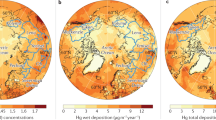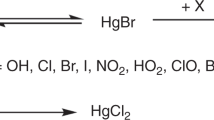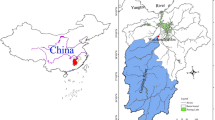Abstract
Atmospheric deposition is a major input of mercury (Hg) to aquatic and terrestrial ecosystems. To evaluate Hg pollution mitigation strategies for inland lakes, the two Great Lakes (Ontario and Erie) adjacent to New York State (NYS), and rural land areas of Upstate New York, the relative contributions to atmospheric Hg deposition from anthropogenic emission reductions and meteorological variations were investigated using a regional three-dimensional chemical transport model with detailed Hg and bromine chemistry (CMAQ-newHg-Br). Our simulations suggested that NYS in-state emissions and the Northeastern US emission reductions from 2005 to 2011 did not significantly alter Hg wet and dry deposition in all study areas when averaged over time and space. However, such emission changes significantly altered intensive emission sources (>10 lb/year) with subsequent effects on deposition to nearby water bodies. For the Great Lakes, Hg dry deposition was enhanced by a factor of 2–5 in the adjacent model grids (within distances of ~12 km downwind), and the enhancements decreased to negligible values over ~50 km distances. Over land, anthropogenic emissions contributed 30% of the spatial variation in Hg dry deposition and 46% in ambient concentrations of gaseous oxidized Hg (GOM). Spatial and temporal variations in meteorology and foliar characteristics were found to affect both Hg wet and dry deposition. Convective precipitation significantly contributed to spatial and seasonal variations (~65%) in Hg wet deposition over both lake and land surfaces, whereas wind speed and surface heat flux were the main factors contributing to the spatial variation in Hg dry deposition over the lake surfaces through their impacts on dry deposition velocities of GOM and PBM. Leaf area index, which regulates deposition velocity, contributed 14% of the spatial variation in dry deposition flux over land. Variation in solar radiation, which influences photochemical formation of GOM and PBM, explained ~10% of the spatial variation over lake and land surfaces alike. Findings from our highly focused study suggested broad implications. Future climate change will likely serve to enhance Hg concentrations in biota via increases in Hg dry and wet deposition to varying degrees contingent on land surface type. Hence, liminating the health risks of Hg requires mitigation of both anthropogenic Hg emission hotspots and human-induced climate change.






Similar content being viewed by others
References
Awad E (2006) The results of the 2003 guide to Eating Ontario Sport Fish Questionnaire. Ontario Ministry of the Environment, Toronto, Ontario, Canada
Baker KR, Bash JO (2012) Regional scale photochemical model evaluation of total mercury wet deposition and speciated ambient mercury. Atmos Environ 49:151–162
Bash JO (2010) Description and initial simulation of a dynamic bidirectional air-surface exchange model for mercury in Community Multiscale Air Quality (CMAQ) model. J Geophys Res Atmos 115:D06305. https://doi.org/10.1029/2009JD012834
Bieser J, Schrum C (2016) Impact of marine mercury cycling on coastal atmospheric mercury concentrations in the North- and Baltic Sea region. Elem Sci Anthr 4:000111. https://doi.org/10.12952/journal.elementa.000111
Blackwell BD, Driscoll CT (2015) Deposition of mercury in forests along a montane elevation gradient. Environ Sci Technol 49:5363–5370. https://doi.org/10.1021/es505928w
Blackwell BD, Driscoll CT, Maxwell JA, Holsen TM (2014) Changing climate alters inputs and pathways of mercury deposition to forested ecosystems. Biogeochemistry 119(1):215–228. https://doi.org/10.1007/s10533-014-9961-6
Bullock OR, Brehme KA (2002) Atmospheric mercury simulation using the CMAQ model: formulation description and analysis of wet deposition results. Atmos Environ 36:2135–2146. https://doi.org/10.1016/S1352-2310(02)00220-0
Byun DW, Pleim JE, Tang RT, Bourgeois A (1999) Meteorology-chemistryinterface processor (MCIP) for models-3 Community Multiscale Air Quality (CMAQ) modeling system. In Byun, DW and Ching, JKS (Eds) Science algorithms of the EPA models-3 Community Multiscale Air Quality (CMAQ) Modeling System, EPA-600/R-99/030, US Environmental Protection Agency Report 12-1–12-91. https://cfpub.epa.gov/si/si_public_record_report.cfm?dirEntryId=63400&Lab=NERL
Desrosiers M, Planas D, Mucci A (2006) Total mercury and methylmercury accumulation in periphyton of Boreal Shield Lakes: Influence of watershed physiographic characteristics Sci Total Environ 355:247–258. https://doi.org/10.1016/j.scitotenv.2005.02.036
Drevnick PE, Engstrom DR, Driscoll CT, Balogh SJ, Kamman NC, Long DT, Muir DGC, Parsons MJ, Rolfhus KR, Rossmann R, Swain EB (2012) Spatial and temporal patterns of mercury accumulation in lacustrine sediments across the Laurentian Great Lakes region. Environ Pollut 161:252–260. https://doi.org/10.1016/j.envpol.2011.05.025
Driscoll CT, Han Y-J, Chen CY, Evers DC, Lambert KF, Holsen TM, Kamman NC, Munson RK (2007) Mercury contamination in forest and freshwater ecosystems in the Northeastern United States. BioScience 57:17–28
Driscoll CT, Mason RP, Chan HM, Jacob DJ, Pirrone N (2013) Mercury as a global pollutant: sources, pathways, and effects. Environ Sci Technol 47:4967–4983
Fisheries and Oceans Canada (2012) 2010 survey of recreational fishing in Canada. Fisheries and Oceans Canada, Ottawa, Ontario, Canada. http://www.dfo-mpo.gc.ca/stats/rec/can/2010/RECFISH2010_ENG.pdf
Fitzgerald WF, Mason RP, Vandal GM (1991) Atmospheric cycling and air-water exchange of mercury over mid-continental lacustrine regions. Water Air Soil Pollut 56:745–767. https://doi.org/10.1007/BF00342314
Gerson JR, Driscoll CT (2016) Is Mercury in a remote forested watershed of the adirondack mountains responding to recent decreases in emissions? Environ Sci Technol 50:10943–10950. https://doi.org/10.1021/acs.est.6b02127
Gerson JR, Driscoll CT, Demers JD et al. (2017) Deposition of mercury in forests across a montane elevation gradient: Elevational and seasonal patterns in methylmercury inputs and production. J Geophys Res: Biogeosciences 122:1922–1939. https://doi.org/10.1002/2016JG003721
GLISA (2014) Climate change in the great lakes region. Great Lakes Integrated Sciences and Assessments (GLISA) Center. http://glisa.umich.edu/media/files/GLISA_climate_change_summary.pdf.
Grömping, U (2006) Relative importance for linear regression in R: the package relaimpo. J Stat Softw, 17(1). https://doi.org/10.18637/jss.v017.i01.
Gronewold AD, Fortin V, Lofgren B, Clites A, Stow CA, Quinn F (2013) Coasts, water levels, and climate change: a Great Lakes perspective. Climatic Change 120:697–711. https://doi.org/10.1007/s10584-013-0840-2
Guo Y, Zhang Y, Ma N, Xu J, Zhang T (2019) Long-term changes in evaporation over Siling Co Lake on the Tibetan Plateau and its impact on recent rapid lake expansion. Atmos Res 216:141–150. https://doi.org/10.1016/j.atmosres.2018.10.006
Halfman JD, O’Neill KA (2009) Water quality of the Finger Lakes. Finger Lakes Institute, Hobart and William Smith Colleges, New York, NY. p 33
Hammerschmidt CR, Fitzgerald WF (2006) Methylmercury cycling in sediments on the continental shelf of southern New England. Geochim Cosmochim Acta 70:918–930
Harris RC, Rudd JWM, Amyot M, Babiarz CL, Beaty KG, Blanchfield PJ, Bodaly RA, Branfireun BA, Gilmour CC, Graydon JA, Heyes A, Hintelmann H, Hurley JP, Kelly CA, Krabbenhoft DP, Lindberg SE, Mason RP, Paterson MJ, Podemski CL, Robinson A, Sandilands KA, Southworthn GR, Louis VLS, Tate MT (2007) Whole-ecosystem study shows rapid fish-mercury response to changes in mercury deposition. Proc Natl Acad Sci USA 104:16586–16591
Lai S-O, Huang J, Hopke PK, Holsen TM (2011) An evaluation of direct measurement techniques for mercury dry deposition. Sci Total Environ 409:1320–1327. https://doi.org/10.1016/j.scitotenv.2010.12.032
Lenters, JD, JB Anderton, P Blanken, C Spence, and AE Suyker (2013) Assessing the impacts of climate variability and change on great lakes evaporation. In: D Brown, D Bidwell, and L Briley, (Eds) 2011 project reports. Great Lakes Integrated Sciences and Assessments (GLISA) Center. http://glisaclimate.org/media/GLISA_Lake_Evaporation.pdf
Lindeman RH, Merenda PF, Gold RZ (1980) Introduction to bivariate and multivariate analysis. Scott, Foresman, Glenview, IL
Mao H, Cheng I, Zhang L (2016) Current understanding of the driving mechanisms for spatiotemporal variations of atmospheric speciated mercury: a review. Atmos Chem Phys 16:12897–12924. https://doi.org/10.5194/acp-16-12897-2016
Mao H, Ye Z, Driscoll C (2017) Meteorological effects on Hg region of New York during 2000–2015. Atmos Environ 168:90–100. https://doi.org/10.1016/j.atmosenv.2017.08.058
Mohapatra SP, Nikolova I, Mitchell A (2007) Managing mercury in the Great Lakes: an analytical review of abatement policies. J Environ Manag 83:80–92. https://doi.org/10.1016/j.jenvman.2006.01.015
Mullins HT, Hinchey EI, Wellner RW, Stephens DB, Anderson Jr. WT, Dwyer TR, Hine AC (1996) Seismic stratigraphy of the Finger Lakes: a continental record of Heinrich event H-1 and Laurentide ice sheet instability. In: Mullins HT, Eylers N (Eds) Subsurface geologic investigations of New York Finger Lakes: implications for late quaternary deglaciation and environmental change. Geological Society of America Special Paper, Boulder, Colorado, p 311
Myers T, Atkinson Jr RD, O. RB, Bash JO (2013) Investigation of effects of varying model inputs on mercury deposition estimates in the Southwest US. Atmos Chem Phys 13:997–1009
NYSDEC (2018) Lake Erie 2017 annual report. New York State Department of Environmental Conservation, Albany, New York, NY, USA
Razavi NR, Cushman SF, Halfman JD et al. (2019) Mercury bioaccumulation in stream food webs of the Finger Lakes in central New York State, USA. Ecotoxicol Environ Saf 172:265–272. https://doi.org/10.1016/j.ecoenv.2019.01.060
Schertzer WM, Rouse WR, Blanken PD, Walker AE (2003) Over-lake meteorology and estimated bulk heat exchange of Great Slave Lake in 1998 and 1999. J Hydrometeor 4:649–659. https://doi.org/10.1175/1525-7541
Simonin HA, Loukmas JJ, Skinner LC, Roy KM (2008) Lake variability: key factors controlling mercury concentrations in New York State fish. Environ Pollut 154:107–115. https://doi.org/10.1016/j.envpol.2007.12.032
Towns J, Cockerill T, Dahan M, Foster I, Gaither K, Grimshaw A, Hazlewood V, Lathrop S, Lifka D, Peterson GD, Roskies R, Scott JR, Wilkins-Diehr N (2014) XSEDE: accelerating scientific discovery. Comput Sci Eng 16:62–74
Wang X, Huang G, Baetz BW, Zhao S (2017) Probabilistic projections of regional climatic changes over the Great Lakes Basin. Clim Dyn 49:2237–2247. https://doi.org/10.1007/s00382-016-3450-7
Watson JEM, Shanahan DF, Di Marco M et al. (2016) Catastrophic Declines in Wilderness Areas Undermine Global Environment Targets Curr Biol 26:2929–2934. https://doi.org/10.1016/j.cub.2016.08.049
Wesely ML (1989) Parameterization of surface resistances to gaseous dry deposition in regional-scale numerical models. Atmos Environ 23:1293–1304
Ye Z, Mao H, Driscoll CT (2019) Primary effects of changes in meteorology vs. anthropogenic emissions on mercury wet deposition: a modeling study. Atmos Environ 198:215–225. https://doi.org/10.1016/j.atmosenv.2018.10.052
Ye Z, Mao H, Driscoll CT, Wang Y, Zhang Y, Jaeglé L (2018) Evaluation of CMAQ coupled with a state-of-the-art mercury chemical mechanism (CMAQ-newHg-Br). J Adv Modeling Earth Syst 10:668–690. https://doi.org/10.1002/2017MS001161
Yu X, Driscoll CT, Warby RAF, Montesdeoca M, Johnson CE (2014) Soil mercury and its response to atmospheric mercury deposition across the northeastern United States. Ecol Appl 24(4):812–822. https://doi.org/10.1890/13-0212.1
Zananski TJ, Holsen TM, Hopke PK, Crimmins BS (2011) Mercury temporal trends in top predator fish of the Laurentian Great Lakes. Ecotoxicology 20:1568–1576. https://doi.org/10.1007/s10646-011-0751-9
Zhang L, Blanchard P, Johnson D et al. (2012) Assessment of modeled mercury dry deposition over the Great Lakes region. Environ Pollut 161:272–283
Zhang L, Wright LP, Blanchard P (2009) A review of current knowledge concerning dry deposition of atmospheric mercury. Atmos Environ 43:5853–5864
Zhang Y, Jaeglé L, van Donkelaar A, Martin RV, Holmes CD, Amos HM, Wang Q, Talbot R, Artz R, Brooks S, Luke W, Holsen TM, Felton D, Miller EK, Perry KD, Schmeltz D, Steffen A, Tordon R, Weiss-Penzias P, Zsolway R (2012) Nested-grid simulation of mercury over North America. Atmos Chem Phys 12:6095–6111. https://doi.org/10.5194/acp-12-6095-2012
Zhou C, Cohen MD, Crimmins BA, Zhou H, Johnson TA, Hopke PK, Holsen TM (2017) Mercury temporal trends in top predator fish of the Laurentian Great Lakes from 2004 to 2015: are concentrations still decreasing? Environ Sci Technol 51:7386–7394. https://doi.org/10.1021/acs.est.7b00982
Acknowledgements
This work was sponsored by the New York State Energy Research and Development Authority (NYSERDA). We are grateful to C. Hogrefe of US EPA for providing the 2004, 2005, 2007, and 2010 WRF simulations. This work used XSEDE, which is supported by National Science Foundation grant number ACI-1548562.
Author information
Authors and Affiliations
Corresponding author
Ethics declarations
Conflict of interest
The authors declare that they have no conflict of interest.
Additional information
Publisher’s note Springer Nature remains neutral with regard to jurisdictional claims in published maps and institutional affiliations.
Rights and permissions
About this article
Cite this article
Ye, Z., Mao, H. & Driscoll, C.T. Impacts of anthropogenic emissions and meteorology on mercury deposition over lake vs land surface in upstate New York. Ecotoxicology 29, 1590–1601 (2020). https://doi.org/10.1007/s10646-019-02113-2
Accepted:
Published:
Issue Date:
DOI: https://doi.org/10.1007/s10646-019-02113-2




